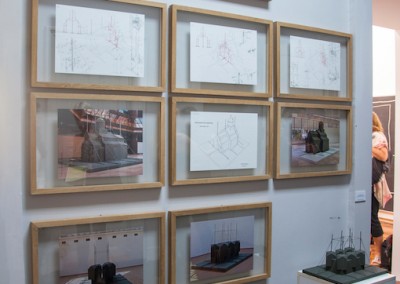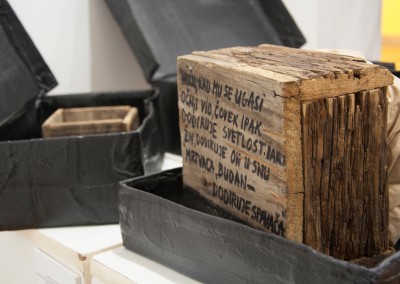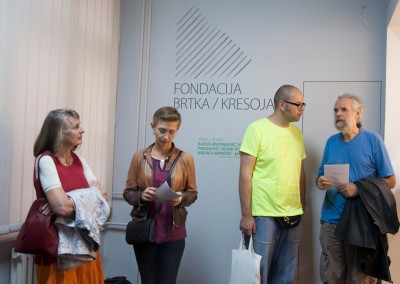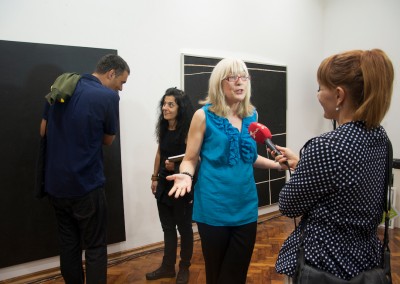Radoš Antonijević, Andrea Ivanović-Jakšić, Veljko Vujaćić, Vesna Perunović
Curated by Sunčica Fenjčev Lambić
SPACES – STATES – MEMORIES
Art in the late 20th and early 21st centuries has changed drastically compared to the preceding age, due to the influence of scientific and technological innovations, the development of telecommunications, changes in politics, economics, demography and culture, not to mention the occurrence of natural disasters. According to Yves Michaud, who defines the period as ”art in a gaseous state”, it is typified by “a globalised and industrialised cultural production”, seen in the wildly varying expressive practices propagated by individuals from different social classes and groups, national and religious backgrounds. On the international map of contemporary art, many points have popped out that are beyond the centrism of Western Europe and North America; the influence of a range of theories and activist movements has led to the flowering of numerous – hitherto vulnerable – groups that are now becoming the protagonists of certain ways of thinking and looking at things. Artists frequently place birth, gender, social, class, racial, sexual and every other possible kind of identity at the focus of attention, addressing all the elements which go to make up ordinary, everyday life: social, political, scientific, technological, culturological, religious, medical, ecological and economic, the mass media and popular culture. Contemporary artists often take up the cudgels in support of societal forms they consider worthy of their personal engagement, which generally leads them to “abandon the auto-referential understanding of art or perhaps to an art which would articulate something metaphysical and beyond reality“. Contemporary art explains that there are “numerous concrete ways in which to exist in the extremely varied existential conditions of a multi-cultural and global world”. According to Michaud, the modern art work rejects the role of symbolisation and with it the status of “sacralised object”, instead of which the aim is to produce “powerful and special experiences“. In contrast to the big stories of historical modernism, there are many micro-stories or minute realities of everyday experience circulating in contemporary art. In this context, both at local and global level, we can recognise similar symptoms of a boundless freedom of choice of themes; these tend mainly to consist of personal stories, subjective narratives through which we may discern the universal, collective state of man in his present-day environment.
The exhibition Spaces – States – Memories brought together four visual artists from Serbia whose works, we might venture to say, reflect the themes of this year’s Danube Dialogues: the relationship of art to crisis. Providing novel ways of communication and perception through the use of various methods, modern art creates new relationships, reveals new possibilities of understanding the state in which we find ourselves, and maps out the various types of crisis in society. The common denominators present in the work of these four artists means that each work speaks in its own way of spaces (real, mental or fictitious), states (emotional, spiritual, social, political, economic etc.), but also of personal and collective memories.
In his tent-sculptures (Dečani, Hagia Sophia, the Belgrade Museum of Contemporary Art), Radoš Antonijević dwells on the loss of values in our society, the disruption of relationships, the advancing of spurious arguments, the loss of true function, the reduction of worth and submitting to the laws of the market, consumerism and leisure. The shapes of the tents conform to their function, the material used and the motif from the technical point of view, the sculptures have all the elements of a common or garden tent, except that their controversial forms are unavoidably associated with collective memory and current events: Dečani alludes to the most traumatic occurrence in recent Serbian history: the war in Kosovo; a tent in the shape of Hagia Sophia represents a kind of hybrid, the blurring of the building’s function throughout history, at once provoking and attractive; another in the form of the Belgrade Museum of Contemporary Art recalls the on-going issues affecting this museum and what it should stand for, while simultaneously following the laws of the modern market, consumerism and economics; it is conceived as vegetating on the elements of reality, somewhere between tent, museum and shopping centre. Documentary material, sketches, drawings, photographs together with a scale-model of the museum-tent form an acceptable installation, as the original tents, now in private and public collections, were too large to be exhibited in the space available.
Veljko Vujačić’s installation Nothing without the Title, executed in situ, was conceived for the gallery where it is exhibited and so is made for that place and at that place alone, an art work created in relation to its surroundings. It represents a kind of minimalism and moots the existence of an art without anything fictive or latent, a totally profane art whose only form of expression is its phenomenological presence. The installation is a palpable thing whose distinctive attributes contain no other connotation apart from referring us to the phenomenological world of experience, but at the same time it alters our perception of space, demanding rapid reaction and a change of state of mind as our experience, memory, cannot anticipate such an outcome. The installation emerges from, or draws on Veljko Vujačić’s previous work. During the 1990s in the middle of a crisis caused by war, sanctions and internal political repression, all of which threw down (in)tolerable challenges to art and artists, Vujačić produced paintings based on modernist principles of abstract (concrete) art, geometry and order, in this manner expressing his feelings towards the chaos which surrounded him. Nothing without the Title is an ephemeral sort of installation; conceived for the particular gallery in which it was created and thus changing the perception and indeed the architecture of its own space, it had to be removed at the end of the exhibition, as the gallery was needed for other activities. The duration of its presence there was documented by photographs.
Vesna Perunović addresses space, identity and memory through questions of borders, exile, home, family transition and impermanency. In the installation Broken China and the video installation Mending Broken China, the artist primarily transmits her personal experience which she links in to the universal political and social context. Broken China consists of paper and cardboard plates painted in black ink to resemble typical tableware. The plates are then cut or broken into pieces, some of the fragments being used to make a circular installation on a wall, while the rest are arranged on a table in front of the wall. A video installation shows the nascent work, the distribution of the pieces and the effort to reassemble them into a whole. Intimate and sensitive, these works essentially carry the message of a disintegrating world; there is dissension in the fragments which are so difficult to join together again – the difficulty of restoring to its proper place what has once, for whatever reason, been broken.
Andrea Ivanović Jakšić in her cycles of paintings, drawings and objects with explicit titles such as Being Man, or Perfecting the Skill of Existing, examines her own internal state. At the same time, however, her works lay down a trail, a testimony of harkening to and observing Man, the world, phenomena and the times we live in. Almost entirely monochrome, black paintings with light accents (lines or barely visible dots which do not disturb the dark tone) and a picture-object in relief, also in dark monochrome, are in communication with the items exhibited: black boxes in which, again, we find objects which could be shown independently of the boxes. Apart from personal narrative and intimate emotional states and memories, we find in these objects that the artist has engaged in a certain way with happenings in today’s society.
This exhibition can only be a passing reference, a sample of the local, domestic scene with all that implies, and through which the global concept of contemporary art may be glimpsed. Through personal example in actual or mental spaces, the revelation of the various states in which artists find themselves in the creative process and which they analyse, each from his or her own personal or collective memories, we may read universal messages, problems, themes that we come across all over the world. The Danube Dialogues go to show that contemporary artists, although perhaps from very different social, political or economic backgrounds, essentially think the same way and struggle, in their own conditions, for the same things.
27 AVG – 11 SEP
Brtka / Kresoja Foundation, Petrovaradin, Beogradska 23, Petrovaradin


























